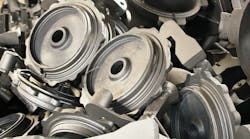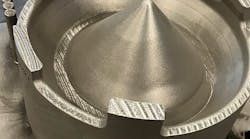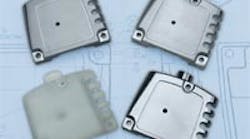In one of New England’s precision manufacturing corridors is a specialty metalcaster that’s earning recognition for its costeffective, innovative production process. The casting technique used by Graphicast Inc. involves graphite molds to cast zinc-aluminum (ZA-12) parts in low- to medium-production runs (300 to 20,000 parts/year), as the core of a business model that is focused on delivering quality, custom-designed products.
The Jaffrey, NH, company offers single-source production that includes in-house design and tooling, as well as netshape casting, together with machining and finishing. A critical factor to Graphicast’s growing reputation is that it is able to offer manufacturers turnaround times that typically are just 4 to 6 weeks from finished computeraided design (CAD) to production of parts.
Typical customers are manufacturers of communications devices; sensor housings; computer and office systems; electronic and electrical cases; industrial machinery and packaging; instruments and controls; and scientific equipment. A recent, well-publicized success story involves Siemens Energy & Automation’s Simatic HawkEye 1600T camera. It’s a compact device that captures images at up to 60 frames per second, for a wide range of quality-control applications.
Two years ago Siemens had completed its design and was proceeding to market with its new camera, when it realized that the diecast aluminum housing would not be ready in time to match production of the optics and circuitry, and that the production requirements would add significantly to the overall unit cost.
Graphicast earned praise for its quick response to filling Siemens’ order for the housing on short notice. It provided the design and production capability that convinced Siemens to change its plans, and delivered the finished housings in just a few weeks.
Once it receives a potential customer’s product design, Graphicast engineers review the requirements and provide the OEM with their evaluation for casting the part. Using 3D solid modeling CAD software, Graphicast’s engineers refine the casting designs, as necessary, to improve it, and even to speed the time to market. Models are produced to indicate draft and radii for the casting process, and any design changes that result are made quickly.
Graphicast produces the necessary tooling for the production series, and casts the part using its proprietary, low-turbulence automatic-fill (LTA) casting technology. LTA is a bottom-filling technique that is rate- and temperature-controlled to ensure the finished castings have high density, low porosity, better surface finish, and more consistent dimensions.
Casting is performed in proprietary, semi-automated machines using graphite molds, bottomfilling to minimize turbulence and porosity. A process controller simultaneously controls fill rate, cycle time, and temperature, and large runners ensure that molten metal fills the mold cavity while the part solidifies, further to minimize shrinkage and porosity. Graphite is a stable and durable mold material that is easy to machine, long lasting, and less expensive than tool steel.
Once the parts are designed and produced, Graphicast offers high-speed CNC machining in-house, and it also has capability for light assembly.
Graphicast points to a series of quality and cost advantages to producing near-net and net shape parts with its graphite mold process, versus sand casting, diecasting, and investment casting — as well as machining, and, in some cases, plastic injection molding.
The metalcaster’s use of the zinc-aluminum alloy is critical to its value proposition. ZA-12 has a density that is approximately the same as cast iron, and it offers excellent, low-temperature castability. ZA-12 castings can be produced at commercial scale with precision tolerances, offer high quality surface finishes, and are easy to machine.
In the way that it leverages customer services with proprietary, high technology, Graphicast is demonstrating that metalcasters can be as innovative as the market demands.










